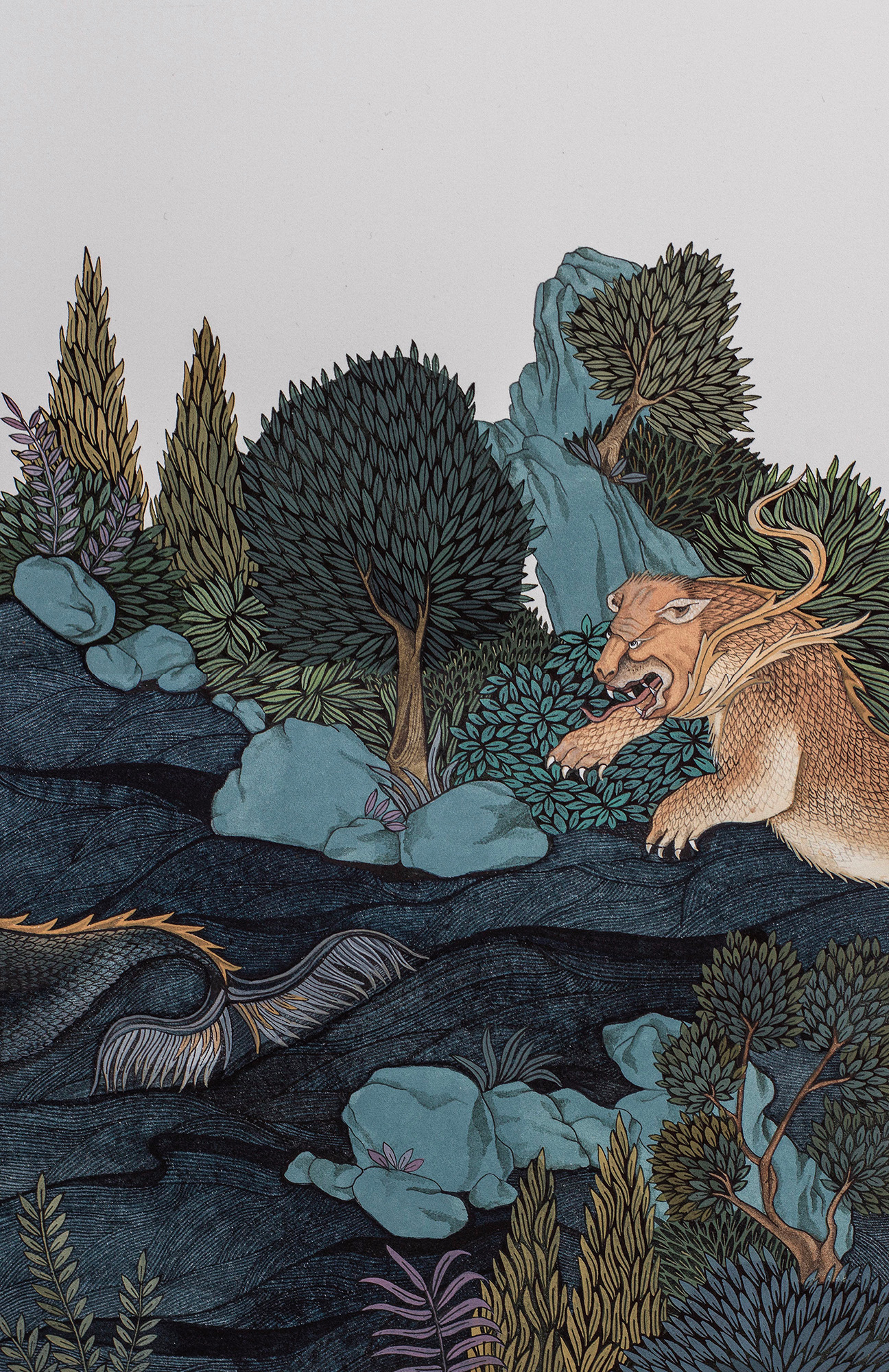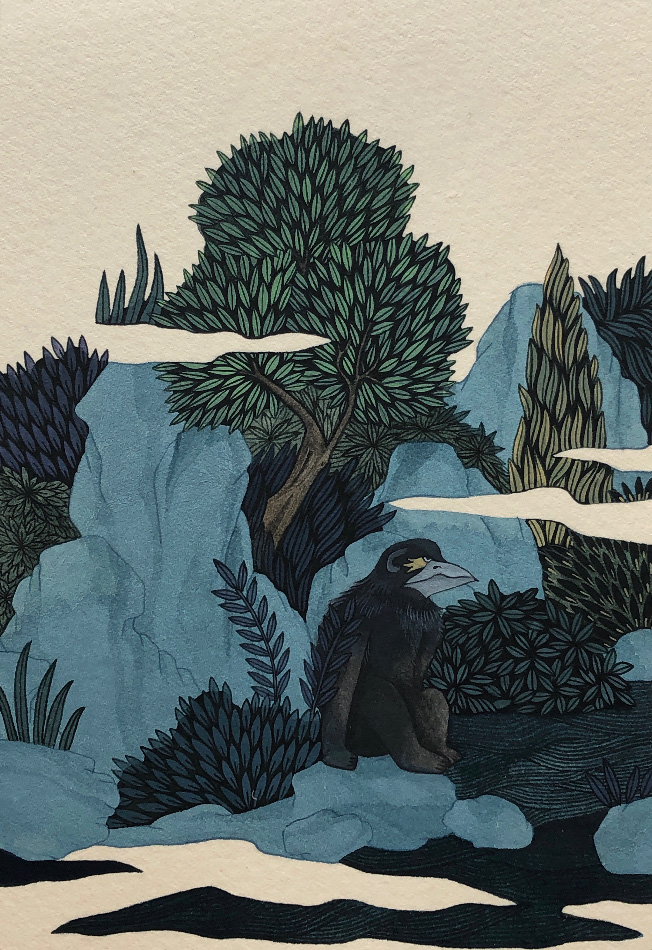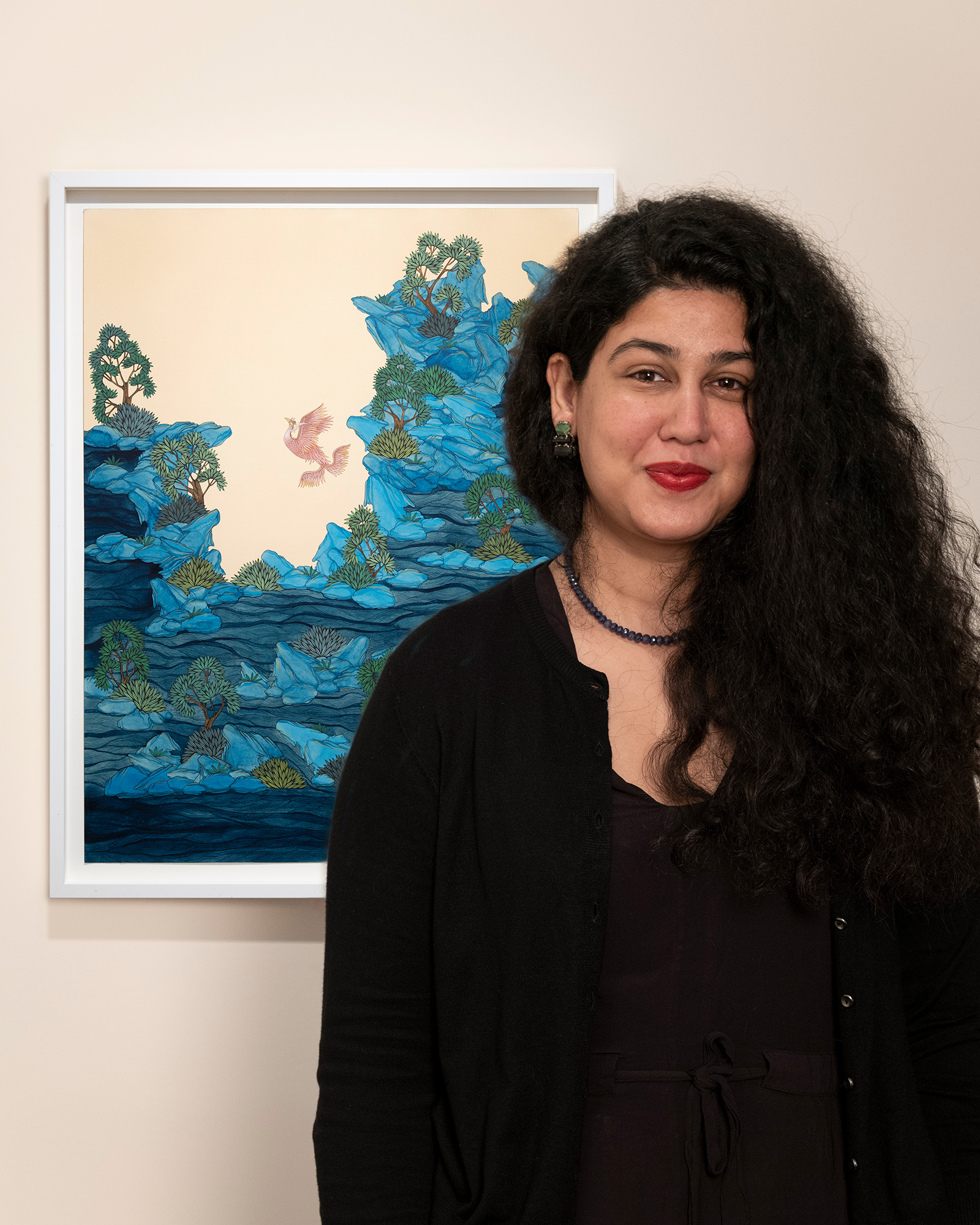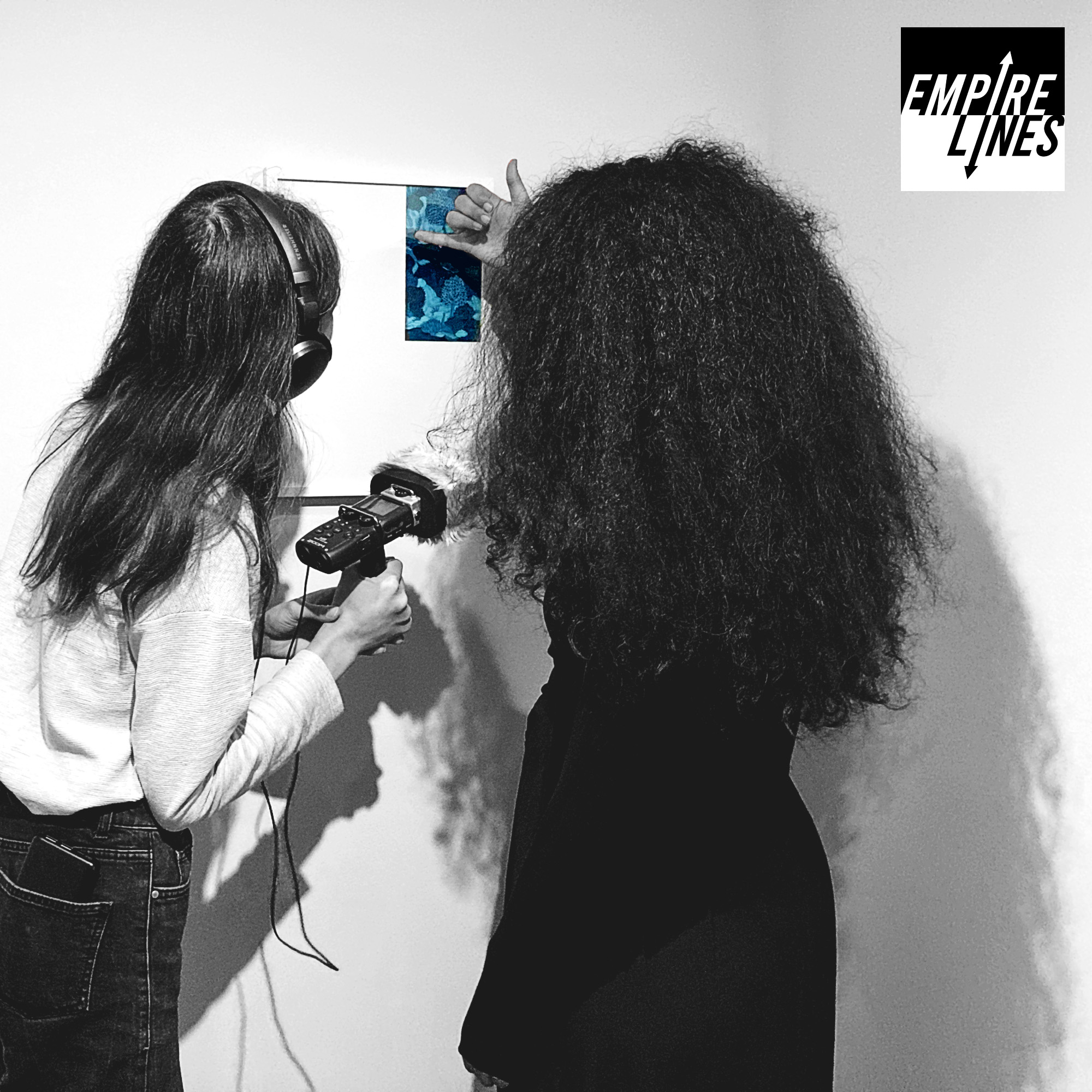The world in miniature: Maha Ahmed’s delicate flow between cultures
At Leighton House in London, Maha Ahmed presents a series of miniature paintings infusing aesthetics, styles, and skills from East Asia to the Middle East. Jelena Sofronijevic visited the exhibition and interviewed the artist for EMPIRE LINES podcast.
Where Worlds Meet captures artist Maha Ahmed’s practice and biography. Born in 1989 in
Pakistan, she studied Miniature Painting at the National College of Arts in
Lahore in 2012, pursuing her practice in that city, then in London, Tokyo, and eventually
Dubai, where she is currently based. Ahmed’s detailed paintings relate to her own
migrations, each one populated with one or two birds in flight – the storks in
her more recent works perhaps too allude to her becoming a mother.
Whilst fantastical and imaginary in subject, these paintings are thoroughly grounded in personal experience. Beyond birds, we find mythical or hybrid creatures, which often seem at odds with their surroundings. In The huntress became the hunted (2018), a solitary tree shades a crow bird, hidden within a rock. A similar animal crops up again, but now empowered, emboldened with bright yellow, in another work from the same year.
![]()
Recurrent motifs, presented in different contexts and meanings, embody the plurality of experiences that even one individual migrant may face. Over time, Ahmed’s titles have shifted, from references to noise, towards solitude, emptiness, and, in her words, meeting “a wall at every turn.” The artist speaks openly of her experience of isolation in Japan, in part due to the language barrier, as well as the loneliness shared by many during COVID lockdowns. Such constraint is also evident in earlier works, such as the ambiguous, rock-formed A bird that could not fly (2017).
Japan, however, also offered Ahmed the meeting points of her artistic journey, as displayed in throughout this Leighton House exhibition. Her miniatures quite clearly draw from traditional Persian and Mughal manuscripts, and classical Japanese art forms. Though historically-informed, her application of colour is wholly contemporary, with rich greens and blues lent from her time working at an illustration studio in Tokyo.
![]()
![]()
fig.ii - Maha Ahmed, Silence your demons (2020)
On the EMPIRE LINES podcast (linked below), Ahmed talks about artistic exchanges between Asia and East Asia, of how woodblock prints, pigments, and dyes were often traded along the Silk Road, inspiring interdisciplinary and multimedia artworks. These are cultural histories which decentre and exclude Western Europe entirely, often absent in the art historical canon.
Indeed, a necessary companion to Where Worlds Meet is Beyond the Page, an exhibition of South Asian Miniature Painting and Britain from 1600 to now on concurrent display at MK Gallery. Featuring contemporary titans as Imran Qureshi – one of the most prominent artists of Lahore’s Miniature Department, which he now heads, and Ahmed’s teacher – it totally undermines the derogation of the media in Western European art and art history.
Beyond the Page curator Hammad Nasar is vocal about why miniatures are often marginalised, due to their size, media (on paper), and means of circulation and display, which do not fit the conventional European museum model. This is echoed in Ahmed’s lived experience; whilst she has enjoyed solo exhibitions at Kristin Hjellegjerde and Asia House in the UK, her works are received differently in other, global contexts, especially Japan, where there is a greater respect for traditional arts.
![]()
To be sure, the artist’s practice seeks to connect, rather than divide or polarise. In particular, she combines both historic and contemporary media; some of her works are aged, with paint layered atop tea and coffee-stained paper. Others are startlingly stark and modern, as Fish-bowl II (2020), one in a series of four works cut sharply into white paper.
This exhibition is her first retrospective, a surprising choice of wording, given her position as a young woman and contemporary artist. (“Don’t you have to be not alive for that?,” one of her friends remarked at the opening of Where Worlds Meet.) Ahmed, however, relates to it more literally, meaning that her life so far is represented on these four walls.
The link back to London comes in An Unfolding (2023), a specially commissioned piece by (and hopefully, for) Leighton House. Like Shahrzad Ghaffari (see 00113), whose abstract helical staircase Oneness (2022) comprises the core of the house’s recent redesign, Ahmed joins a growing group of contemporary, SWANA-based artists invited to respond to the multicultural aesthetics of its interiors, architecture, and collection – in particular, the vivid ceramic tiles from Turkey and Greece, Egypt, and Syria, which adorn the 18th century Arab Hall.
![]()
An Unfolding references the important role of greens, blues, and ochres in Islamic culture, and colour more widely non-representational art. Ahmed, like many travelled visitors to Leighton House, also draws from the Blue Mosque in Istanbul; as a Muslim, she feels “comfortable appropriating the colours of Arab Hall.” (Her recent Galerie ISA exhibition, Of Holding On and Letting Go, references the Persian poet Rumi, an influence also shared with Ghaffari.)
In quiet conversation, the artist suggests a preference for the intimate, low ceilings of the exhibition space beneath the Hall. Perhaps it serves as a hiding place, but there’s a playfulness it permits too. Ahmed also paints a trail of birds on the walls for visitors to find, encouraging a kind of physical movement, a searching, which emulates her own global travels. Some of the creatures can be animated with a slightly-stilted augmented reality, the museum’s first experiment with AR, which may serve to improve access to the works.
Where Worlds Meet does deserve the bigger space and better lighting of the larger room upstairs, which currently indulges in a more conventional display of Victorian painting. But this selection is more subtle and subversive, a literal undermining of the hegemonies and hierarchies of art history. Indeed, it’s fitting to find Ahmed at the base of Oneness, the foundations of Ghaffari’s architectural masterpiece, an artwork which speaks not to linear progression, but more constructively, the two-way flows between times, spaces, and cultures.
![]()
![]()
figs.v,vi
Whilst fantastical and imaginary in subject, these paintings are thoroughly grounded in personal experience. Beyond birds, we find mythical or hybrid creatures, which often seem at odds with their surroundings. In The huntress became the hunted (2018), a solitary tree shades a crow bird, hidden within a rock. A similar animal crops up again, but now empowered, emboldened with bright yellow, in another work from the same year.

fig.i
Recurrent motifs, presented in different contexts and meanings, embody the plurality of experiences that even one individual migrant may face. Over time, Ahmed’s titles have shifted, from references to noise, towards solitude, emptiness, and, in her words, meeting “a wall at every turn.” The artist speaks openly of her experience of isolation in Japan, in part due to the language barrier, as well as the loneliness shared by many during COVID lockdowns. Such constraint is also evident in earlier works, such as the ambiguous, rock-formed A bird that could not fly (2017).
Japan, however, also offered Ahmed the meeting points of her artistic journey, as displayed in throughout this Leighton House exhibition. Her miniatures quite clearly draw from traditional Persian and Mughal manuscripts, and classical Japanese art forms. Though historically-informed, her application of colour is wholly contemporary, with rich greens and blues lent from her time working at an illustration studio in Tokyo.


fig.ii - Maha Ahmed, Silence your demons (2020)
fig.iii - Maha Ahmed, Noise of Solitude (2020)
On the EMPIRE LINES podcast (linked below), Ahmed talks about artistic exchanges between Asia and East Asia, of how woodblock prints, pigments, and dyes were often traded along the Silk Road, inspiring interdisciplinary and multimedia artworks. These are cultural histories which decentre and exclude Western Europe entirely, often absent in the art historical canon.
Indeed, a necessary companion to Where Worlds Meet is Beyond the Page, an exhibition of South Asian Miniature Painting and Britain from 1600 to now on concurrent display at MK Gallery. Featuring contemporary titans as Imran Qureshi – one of the most prominent artists of Lahore’s Miniature Department, which he now heads, and Ahmed’s teacher – it totally undermines the derogation of the media in Western European art and art history.
Beyond the Page curator Hammad Nasar is vocal about why miniatures are often marginalised, due to their size, media (on paper), and means of circulation and display, which do not fit the conventional European museum model. This is echoed in Ahmed’s lived experience; whilst she has enjoyed solo exhibitions at Kristin Hjellegjerde and Asia House in the UK, her works are received differently in other, global contexts, especially Japan, where there is a greater respect for traditional arts.

fig.iv
To be sure, the artist’s practice seeks to connect, rather than divide or polarise. In particular, she combines both historic and contemporary media; some of her works are aged, with paint layered atop tea and coffee-stained paper. Others are startlingly stark and modern, as Fish-bowl II (2020), one in a series of four works cut sharply into white paper.
This exhibition is her first retrospective, a surprising choice of wording, given her position as a young woman and contemporary artist. (“Don’t you have to be not alive for that?,” one of her friends remarked at the opening of Where Worlds Meet.) Ahmed, however, relates to it more literally, meaning that her life so far is represented on these four walls.
The link back to London comes in An Unfolding (2023), a specially commissioned piece by (and hopefully, for) Leighton House. Like Shahrzad Ghaffari (see 00113), whose abstract helical staircase Oneness (2022) comprises the core of the house’s recent redesign, Ahmed joins a growing group of contemporary, SWANA-based artists invited to respond to the multicultural aesthetics of its interiors, architecture, and collection – in particular, the vivid ceramic tiles from Turkey and Greece, Egypt, and Syria, which adorn the 18th century Arab Hall.

fig.v - Maha Ahmed, An Unfolding (2023)
An Unfolding references the important role of greens, blues, and ochres in Islamic culture, and colour more widely non-representational art. Ahmed, like many travelled visitors to Leighton House, also draws from the Blue Mosque in Istanbul; as a Muslim, she feels “comfortable appropriating the colours of Arab Hall.” (Her recent Galerie ISA exhibition, Of Holding On and Letting Go, references the Persian poet Rumi, an influence also shared with Ghaffari.)
In quiet conversation, the artist suggests a preference for the intimate, low ceilings of the exhibition space beneath the Hall. Perhaps it serves as a hiding place, but there’s a playfulness it permits too. Ahmed also paints a trail of birds on the walls for visitors to find, encouraging a kind of physical movement, a searching, which emulates her own global travels. Some of the creatures can be animated with a slightly-stilted augmented reality, the museum’s first experiment with AR, which may serve to improve access to the works.
Where Worlds Meet does deserve the bigger space and better lighting of the larger room upstairs, which currently indulges in a more conventional display of Victorian painting. But this selection is more subtle and subversive, a literal undermining of the hegemonies and hierarchies of art history. Indeed, it’s fitting to find Ahmed at the base of Oneness, the foundations of Ghaffari’s architectural masterpiece, an artwork which speaks not to linear progression, but more constructively, the two-way flows between times, spaces, and cultures.


figs.v,vi
Maha Ahmed (B. 1989, Pakistan) completed a MA in Fine Art at Central Saint Martins School of Art, London on the Caspian Art Foundation Scholarship (2015) and a BFA in Miniature Painting at the National College of Arts, Lahore (2012).
Maha is represented by Kristin Hjellegjerde Gallery.
www.kristinhjellegjerde.com/artists/148-maha-ahmed
Jelena Sofronijevic is an audio producer & freelance journalist who creates content at the intersections of cultural and political history. They are the producer of EMPIRE LINES, a podcast which uncovers the unexpected flows of empires through art, and historicity, a new series of audio walking tours, exploring how cities got to be the way they are.
www.jelsofron.com
EMPIRE LINES
historicity
Maha is represented by Kristin Hjellegjerde Gallery.
www.kristinhjellegjerde.com/artists/148-maha-ahmed
Jelena Sofronijevic is an audio producer & freelance journalist who creates content at the intersections of cultural and political history. They are the producer of EMPIRE LINES, a podcast which uncovers the unexpected flows of empires through art, and historicity, a new series of audio walking tours, exploring how cities got to be the way they are.
www.jelsofron.com
EMPIRE LINES
historicity
visit
Maha Ahmed: Where Worlds Meet is on view at Leighton
House in London until 3 March. More details available at: www.rbkc.gov.uk/museums/maha-ahmed-where-worlds-meet
Beyond the Page: South Asian Miniature Painting and
Britain, 1600 to now is on at MK Gallery until 28 January. More details
available at: www.mkgallery.org/event/beyond-the-page
listen to the podcast
The podcast episodes Where Worlds Meet, Maha Ahmed (2023) (EMPIRE
LINES x Leighton House) and Did You Come Here To Find History?, Nusra Latif Qureshi (2009) (EMPIRE LINES x MK Gallery, The Box) are both freely available to listen to and available at: www.pod.link/1533637675
images
figs.i,iv Maha Ahmed, Where Worlds Meet at Leighton House © RBKC. Image Jaron James
fig.ii Maha Ahmed, Silence your demons (2020) ©Maha Ahmed. Courtesy of Kristin Hjellegjerde Gallery
fig.iii Maha Ahmed, Noise of Solitude (2020) ©Maha Ahmed. Courtesy of Kristin Hjellegjerde Gallery
fig.v Maha Ahmed, An Unfolding (2023) © RBKC. Image Jaron James
fig.vi
©
EMPIRE LINES
fig.vii Maha Ahmed, artist © RBKC. Image Jaron James
publication date
05 January 2024
tags
Maha Ahmed, Birds, East Asia, Shahrzad Ghaffari, Kristin Hjellegjerde, Japan, Leighton House, Miniature, MK Gallery, Mughal, Muslim, Hammad Nasar, Painting, Persia, Imran Qureshi, Silk Road, Jelena Sofronijevic
Beyond the Page: South Asian Miniature Painting and Britain, 1600 to now is on at MK Gallery until 28 January. More details available at: www.mkgallery.org/event/beyond-the-page
The podcast episodes Where Worlds Meet, Maha Ahmed (2023) (EMPIRE
LINES x Leighton House) and Did You Come Here To Find History?, Nusra Latif Qureshi (2009) (EMPIRE LINES x MK Gallery, The Box) are both freely available to listen to and available at: www.pod.link/1533637675
images
figs.i,iv Maha Ahmed, Where Worlds Meet at Leighton House © RBKC. Image Jaron James
fig.ii Maha Ahmed, Silence your demons (2020) ©Maha Ahmed. Courtesy of Kristin Hjellegjerde Gallery
fig.iii Maha Ahmed, Noise of Solitude (2020) ©Maha Ahmed. Courtesy of Kristin Hjellegjerde Gallery
fig.v Maha Ahmed, An Unfolding (2023) © RBKC. Image Jaron James
fig.vi
©
EMPIRE LINES
fig.vii Maha Ahmed, artist © RBKC. Image Jaron James
publication date
05 January 2024
tags
Maha Ahmed, Birds, East Asia, Shahrzad Ghaffari, Kristin Hjellegjerde, Japan, Leighton House, Miniature, MK Gallery, Mughal, Muslim, Hammad Nasar, Painting, Persia, Imran Qureshi, Silk Road, Jelena Sofronijevic
fig.ii Maha Ahmed, Silence your demons (2020) ©Maha Ahmed. Courtesy of Kristin Hjellegjerde Gallery
fig.iii Maha Ahmed, Noise of Solitude (2020) ©Maha Ahmed. Courtesy of Kristin Hjellegjerde Gallery
fig.v Maha Ahmed, An Unfolding (2023) © RBKC. Image Jaron James
fig.vi © EMPIRE LINES
fig.vii Maha Ahmed, artist © RBKC. Image Jaron James
publication date
05 January 2024
tags
Maha Ahmed, Birds, East Asia, Shahrzad Ghaffari, Kristin Hjellegjerde, Japan, Leighton House, Miniature, MK Gallery, Mughal, Muslim, Hammad Nasar, Painting, Persia, Imran Qureshi, Silk Road, Jelena Sofronijevic


